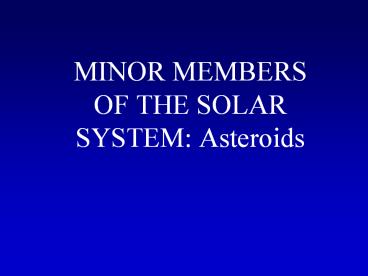MINOR MEMBERS OF THE SOLAR SYSTEM: Asteroids
Title:
MINOR MEMBERS OF THE SOLAR SYSTEM: Asteroids
Description:
Orbit at Lagrangian Points (60 ahead and behind Jupiter) ... Collisions between asteroids produce smaller fragments (families of asteroids) ... –
Number of Views:1250
Avg rating:3.0/5.0
Title: MINOR MEMBERS OF THE SOLAR SYSTEM: Asteroids
1
- MINOR MEMBERS OF THE SOLAR SYSTEM Asteroids
2
- Images of three asteroids, taken during
spacecraft flybys, shown to scale (Mathilde is 59
km wide and 47 km high)
3
General Thesis
- Asteroids and Comets are relics of the early
stages of accretion of the solar nebula
4
I History of Discovery
- A gap in the known planetary system between
Mars (1.5 AU) and Jupiter (5.2 AU) - The Titius-Bode law (purely numerical relation)
predicted a planet in the gap between Mars and
Jupiter
5
Titius-Bode Law
Planet Calculated distance True distance
Mercury (04)/10 0.4 0.39
Venus (34)/10 0.7 0.73
Earth (64)/10 1.0 1.00
Mars (124)/10 1.6 1.5
? (244)/10 2.8
Jupiter (484)/10 5.2 5.2
Saturn (964)/10 10.0 9.6
Uranus (1924)/10 19.6 19.2
6
Asteroid discoveries
- Discoveries Ceres 1801, Pallas 1802, Juno 1804,
Vesta 1807 - Largest is Ceres (940 km diameter)
- Photography (after 1890s) allowed discovery of
many more asteroids - As many as several million with diameters of 1 km
or more - Total mass 1/20 mass of Moon
7
II Classification of Asteroids
- Belt Asteroids
- Semimajor axes 2.23.3 AU
- Periods 3.36 years
- Families of asteroids (similar orbits, surface
appearance) may be fragments of a single asteroid
produced by collisions - Some gaps in belt caused by resonances with
Jupiter
8
Belt asteroids
9
Trojans
- Orbit at Lagrangian Points (60 ahead and behind
Jupiter) - Stable orbits the asteroids will not be swept
up by Jupiter - May be several thousand in number
- Size Most are a few km, some are gt100 km
10
Trojan Asteroids
11
Earth-approaching
- May be several thousand gt1 km diameter
- Radar images are available for several that
approached Earth - Amor
- Have orbits crossing Marss orbit
- Perihelion distances between 1.017 and 1.4 AU (ie
between Earth and Mars)
12
Apollo
- Cross Earths orbit but have semimajor axes
greater than 1.0 AU (elliptical orbits!) - Aten
- Have orbits with semimajor axes of less than 1.0
AU (inside Earths orbit!)
13
Centaurs
- Orbit beyond Jupiter
- eg Hidalgo A 5.9 AU
- Chiron A 13.7 AU (beyond Saturn)
- Are these asteroids or comets?
14
Kuiper Belt Asteroids?
- Beyond Neptune ( 40 AU) a growing number of
small bodies have been discovered - Are these asteroids or comets?
- Distinction may be unimportant all bodies out
here are ice-balls like comets! - The Kuiper Belt
- A belt of many orbiting icy chunks
- Perturbations alter orbit of Kuiper Belt object
and can send it into inner solar system ? comet !
15
- Several space missions have brought back close-up
pictures of asteroids - Galileo spacecraft flew by Gaspra and Ida
- NEAR spacecraft flew by Mathilde.
16
(No Transcript)
17
(No Transcript)
18
(No Transcript)
19
Origin of the Asteroids
- Debris left over from formation of solar system.
(Accretion process limited by tidal effects of
Jupiter). - Total mass (1/20 mass of moon) is too low to have
been remnants of a planet. - Collisions between asteroids produce smaller
fragments (families of asteroids) and meteoroids,
some of which fall on Earth.
20
IV Collisions between Asteroids and the Earth?
- Evidence that impact of 10 km asteroid 65
million years ago, at end of Cretaceous Period - led to the extinction of the dinosaurs
- enhanced Iridium in layer at K-T
(Cretaceous-tertiary) boundary in sediments
worldwide - Chicxulub crater (200 km) in Yucatan, Mexico
- Tunguska event (30 June 1908) in Siberia, may
have been an impact with a 100,000 ton body
21
Watch Out!
- Estimated that impacts like the K-T impact occur
about every 100 million years. - Results could be catastrophic to civilization!































